How
much UVB do wild reptiles get?
The results
of our measurements of solar UVB
from across the world show clearly that in the course of a single day, reptiles in the wild would be exposed to huge variations in the amount of UVB they receive, depending on the time of day and amount of cloud cover; whether the reptile is in sun or shade, and whether sunlit objects nearby are reflecting more or less UVB in the reptile's direction.
This does not mean that all reptiles need exposure to UVB
light, only that it is normally present in their environment.
When reptiles choose to bask in full sun, they receive large
amounts: even in the 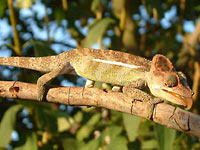 UK
this may be 20-30 times the level they receive in the shade.
Many reptiles never choose to do so, however. Some species
live almost entirely in leafy shade or in burrows; nocturnal
reptiles and crepuscular (dawn and dusk) species actively
avoid bright daylight although some may bask in late evening
sun. Even sun-worshippers retreat from the sun at certain
times during the day, and many species are "shuttle heliotherms",
moving in and out of sunlight many times as they thermoregulate
during the course of the day. UK
this may be 20-30 times the level they receive in the shade.
Many reptiles never choose to do so, however. Some species
live almost entirely in leafy shade or in burrows; nocturnal
reptiles and crepuscular (dawn and dusk) species actively
avoid bright daylight although some may bask in late evening
sun. Even sun-worshippers retreat from the sun at certain
times during the day, and many species are "shuttle heliotherms",
moving in and out of sunlight many times as they thermoregulate
during the course of the day.
Variation in skin sensitivity to UVB light.
All living things on the surface of the planet are exposed to ultraviolet light to some extent. Diffused and reflected UVB will penetrate into deep shade and even nocturnal creatures may be exposed to small amounts whilst hidden in their daytime retreats, particularly in locations where daytime UVB levels are high.
It
is likely that all reptiles can synthesise vitamin D in
their skin when exposed to UVB light. Very few vertebrates
do
not synthesise its precursor, provitaminD, in the skin.23
Two
related studies compared the sensitivity of the skins of
four species of lizard - a crepuscular house gecko, a shade-dwelling
anole, an anole which basks in sunshine, and the sun-dwelling
Texas spiny lizard. The amount of vitamin D3 synthesised
by the skin of each of the species was compared. They found
that the skin sensitivity was related to the amount of exposure
to UVB light the reptiles would normally receive in the
wild. The Texas spiny lizard skin was the most insensitive;
in a high UVB environment, this thick skin might well be
resistant to UV damage and yet still produce sufficient
vitamin D3. The house gecko skin was the most sensitive;
presumably this gecko would be able to make the most of
the smallest amounts of ultraviolet light that came its
way.9,16
We have
conducted a new study on the way the skin of reptiles from
different habitats varies in its transmission of UVB light,
by examining the shed skin from a range of species from
very different environments. We have found that in general,
our findings tie in well with those described above. Lizards
which are normally exposed to high levels of UV light have
shed skin which lets only a small percentage through to
its deeper layers; this barrier would thus presumably have
a protective function. Species that would receive lower
levels of UVB in their environment have shed skin which
lets a higher percentage of UVB light through.
However, we had the opportunity to test samples from males,
females and juveniles from one species (the panther chameleon)
and we found that juveniles and a gravid female had skin
that was more transparent to UVB than males and an
older female, which presumably have lower vitamin D3 requirements.
It is thus possible that there is a dynamic balance between
a reptile's need for protection from excessive UV, and for
its need to allow UV to reach deeper skin layers for the
purpose of D3 synthesis.
Our
results are described fully on the separate page The
Transmission of Ultraviolet Light through Reptile Skin Shed.
(click to view in a new window. Also accessible from the
side navigation bar in the normal way.)
How
much UVB do reptiles need?
There is no easy answer to this. For millions 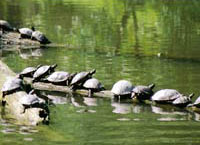 of years, our reptiles have lived in a world in which UVB,
UVA and visible light are all around them, and different
species have evolved in every ecological niche, with behaviours
(such as basking preferences) and body characteristics (such
as thick or thin skin, heavy or light pigmentation) to equip
them to use what UVB is available to them, in the most efficient
way possible.
of years, our reptiles have lived in a world in which UVB,
UVA and visible light are all around them, and different
species have evolved in every ecological niche, with behaviours
(such as basking preferences) and body characteristics (such
as thick or thin skin, heavy or light pigmentation) to equip
them to use what UVB is available to them, in the most efficient
way possible.
It would seem logical that keepers
cannot go far wrong if they seek to emulate the natural
UVB environment inhabited by the species they keep.
There is hardly any scientific data to back the recommendation
of any particular level of UVB for any particular species.
Most suggestions are still based on keepers' personal experiences
although slowly, new data is being collected and advances
in our understanding are being made. Studies on UVB light,
basking preferences, and vitamin D3 production are appearing
steadily, and work has been done on species as diverse as
chuckwallas, iguanas and chameleons.
Researchers
have charted the response of D3 deficient green iguanas
and Komodo dragons to ultraviolet light and measured the
serum levels of calcediol in wild lizards including green
iguanas, crocodile monitors, and Komodo dragons.1,8,20,27
In
the USA it is becoming fairly common for iguana owners to
include blood tests for serum calcediol levels in their
regular veterinary health checks.27
Self-determination
We all know that reptiles need a "heat gradient" and part of their normal behaviour involves moving in and out of the warmth so that they maintain a healthy body temperature. Since some reptiles are also aware of ultraviolet light "gradients" and will actually move in and out of them according to their bodily vitamin D3 status and requirements, it would thus seem very appropriate to provide our animals with UV light in the same way we provide heat, ensuring they can choose how much, or how little UV they absorb by establishing a UVB gradient in our vivaria.
We have observed the behaviour of some of our lizards, and their reactions to UVB light supplied in different ways.
Bearded dragons (Pogona vitticeps),
both adults and hatchlings, kept under fluorescent lights
providing UVB chose mainly to bask directly under the basking
lamp used as a heat source, rather than the UV light.
Therefore if using fluorescent tubes as a UVB source, these
should be placed as close as possible to the basking zone.
Collared lizards (Crotaphytus collaris) supplied
with the same fluorescent lamps were observed to sit 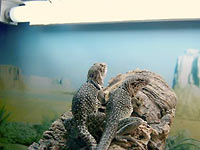 much closer to the UV source for several hours in the morning
and afternoon, moving away throughout the middle of the
day. This might be indicative of their behaviour in the
wild, where the natural heat, light and UVB levels reach
a high at midday. (Figure 3)
much closer to the UV source for several hours in the morning
and afternoon, moving away throughout the middle of the
day. This might be indicative of their behaviour in the
wild, where the natural heat, light and UVB levels reach
a high at midday. (Figure 3)
When a mercury vapour lamp with a higher UVB output was introduced to the
bearded dragons, however, a change in behaviour was seen. Their activity levels increased and they chose to bask directly under the mercury vapour bulb, rather than their incandescent basking lamp, for much of the day. In particular, one adult bearded dragon
recoverin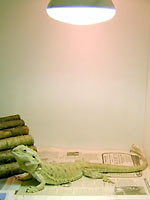 g from metabolic bone disorder (the result of a lack of UVB in
the past) basked directly underneath the UV source for most of the day, sitting as close as she could safely get (which with this particular lamp, was 12"). This dragon was never seen basking under the fluorescent tube that was provided for her before the mercury vapour lamp was installed. (Figure
4) g from metabolic bone disorder (the result of a lack of UVB in
the past) basked directly underneath the UV source for most of the day, sitting as close as she could safely get (which with this particular lamp, was 12"). This dragon was never seen basking under the fluorescent tube that was provided for her before the mercury vapour lamp was installed. (Figure
4)
Controlled experiments would be needed to ensure that the
reptiles were not merely attracted to the mercury vapour
lamps because of their bright visible light; however, these
observations do tie in well with the published findings
cited earlier, that lizards are not only attracted to ultraviolet
light, but appear to know when they need to absorb more
UVB, and increase their basking time accordingly.15
There
are also reports of the same behaviour in green
iguanas (Iguana iguana) under UVB treatment for metabolic
bone disorder. Early in the course of their therapy, they
choose to lie right under high-intensity UVB lamps for most
of the day, at levels of around 175uW/cm² (the maximum offered).
As recovery progresses, they move towards the edges of the
high-UVB zone.33
Such observations further highlight the need to provide
a "light gradient", whereby reptiles can move in and out
of the UV range at their own preference, as they would do
in the wild. It is also important to ensure that the ultraviolet
light is placed close enough to the warm basking spot that
a reptile can obtain both heat and ultraviolet light together.
If a reptile has the choice between two equally bright lamps,
one of which emits UVB, it will prefer that one 15;
however, if the UVB source is not as bright, reptiles may
select the brightest or warmest part of the vivarium for
basking, and thus fail to benefit from the ultraviolet light.
12
UVB Recommendations for different species.
"Sun-worshippers"
Some reptiles are described as "sun-worshippers" including
uromastyx,
bearded dragons, chuckwallas,
and many species of tortoise.
In the wild, these spend many hours a day exposed to hot
sunshine and high UVB levels, in places 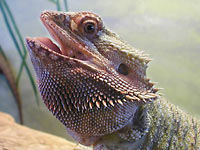 such as the Mediterranean, Arizona and the Australian outback.
Peak readings of 350 - 450uW/cm² are commonplace for two
or three hours a day, around noon, in the summertime in
these areas; however, even "sun-worshippers" avoid
the midday sun. Observers usually report that most basking
is done in full sun before 10.30am, when readings are considerably
lower.
such as the Mediterranean, Arizona and the Australian outback.
Peak readings of 350 - 450uW/cm² are commonplace for two
or three hours a day, around noon, in the summertime in
these areas; however, even "sun-worshippers" avoid
the midday sun. Observers usually report that most basking
is done in full sun before 10.30am, when readings are considerably
lower.
Frequently, lizards are seen basking in full sun (or under
basking lamps) with their mouths wide open. This gaping
is a mechanism for heat loss; the saliva evaporating from
mouth and tongue cools the body. In an arid environment,
animals do not deliberately lose water 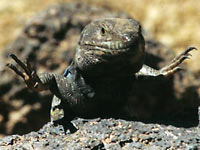 un-necessarily. un-necessarily.
Other species of basking lizards lie on rocks so hot they
lift their feet to avoid burning them. Why would a wild
animal continue to bask in the open, risking been seen by
a predator, when it is already too hot? Is it possible that
the reptile is choosing to stay out for longer, in order
to absorb more ultraviolet light?
When kept in captivity these species need - and seek out
- high levels of ultraviolet light to enable them to produce
enough vitamin D3 to remain healthy. However, there are
no published guidelines regarding the optimum UVB levels
for these species. We can only offer observations.
Chuckwallas (Sauromalus obesus)
appear to thrive under strong lighting in the vivarium,
choosing to bask in areas of high UVB exposure for part
of the day when this is available to them. In one study
3 these
were offered gradients of up to 92uW/cm² (estimated reading
if measured with a Solarmeter 6.2, according to conversion
factors published by Gehrmann et al 19)
and they preferred the zones with highest UVB, moving in
and out of these areas freely, however, just as they move
in and out of hot basking spots.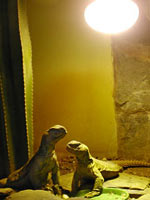
A thriving group of Uromastyx
aegyptius in a zoo in the UK have been given
access to high UVB supplied by a commercial tanning lamp
for several years. The lizards are reported to bask frequently
right under this lamp.39
One of the current authors keeps
bearded dragons (Pogona vitticeps) and chuckwallas
(Sauromalus ater) with access to a gradient
of up to 140uW/cm² under mercury vapour and metal halide
lamps. These bask right under their lamps in the zone of
maximum UVB, and seem to spend most of their time, when
not basking, in the regions where UVB levels are between
30 and 75 uW/cm².
Rainforest
Species
Rainforest species such as some types of
chameleon naturally avoid any such high exposure.
They need UVB, but at much lower levels. 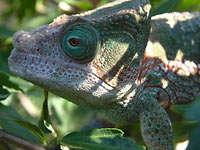 Their more sensitive skins manufacture all the vitamin D3
which they need from brief periods of basking early and
late in the day, and the diffused and reflected ultraviolet
light permeating the rainforest shade. All species of chameleon
have different requirements, but authors vary, too, in their
recommendations. The one scientific study we are aware of
addresses egg hatchability in Panther
Chameleons (Furcifer pardalis) and the authors
suggest that a low level of UVB (a gradient between 15-33uW/cm²
as measured with a Solarmeter 6.2) supplied for 12 hours
a day is optimal. High levels are seen to be harmful.14,19
Our experiences are similar to these findings; one of the
current authors maintains gradients of up to 30uW/cm² in
all his chameleon vivaria.
Their more sensitive skins manufacture all the vitamin D3
which they need from brief periods of basking early and
late in the day, and the diffused and reflected ultraviolet
light permeating the rainforest shade. All species of chameleon
have different requirements, but authors vary, too, in their
recommendations. The one scientific study we are aware of
addresses egg hatchability in Panther
Chameleons (Furcifer pardalis) and the authors
suggest that a low level of UVB (a gradient between 15-33uW/cm²
as measured with a Solarmeter 6.2) supplied for 12 hours
a day is optimal. High levels are seen to be harmful.14,19
Our experiences are similar to these findings; one of the
current authors maintains gradients of up to 30uW/cm² in
all his chameleon vivaria.
Iguanas appear to have requirements
- and behaviour patterns - 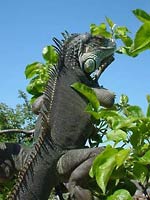 somewhere between the two. Green
iguanas (Iguana iguana) have been observed
to bask for long periods in full sunlight early and late
in the day, when UVB levels are lower, then move to leafy
shade during the heat of the day. Here they avoid the high
UVB of the tropical noonday sun, which can be as high as
450 uW/cm², but they continue to be exposed to considerable
amounts of reflected and diffused UVB which may reach values
little different from those of the morning and evening sun
in which they bask freely; levels of 200uW/cm² have been
recorded.27,32
somewhere between the two. Green
iguanas (Iguana iguana) have been observed
to bask for long periods in full sunlight early and late
in the day, when UVB levels are lower, then move to leafy
shade during the heat of the day. Here they avoid the high
UVB of the tropical noonday sun, which can be as high as
450 uW/cm², but they continue to be exposed to considerable
amounts of reflected and diffused UVB which may reach values
little different from those of the morning and evening sun
in which they bask freely; levels of 200uW/cm² have been
recorded.27,32
One
author recommends keepers of green
iguanas to make levels of at least 75-150 uW/cm²
available to their animals for at least 6 hours a day, and
reports that iguanas, given the opportunity to do so, choose
to bask at these levels. 32,33
Another study indicates that an absolute minimum of 10uW/cm²
is required for maintaining adequate vitamin D3 levels,
but the author recommends that keepers aim for a gradient
of 20 - 40 uW/cm² in the iguana's basking spot. 27
However, these levels would all be around the very minimum
level a wild iguana would experience during the day, whilst
in deep shade; iguanas are not shade dwellers. The
recommendation first described (around 100 uW/cm² in the
basking zone itself, with a gradient into shade) would seem
much more appropriate.
Creatures of Dusk and
Dawn
Crepuscular
lizards (active at dusk and dawn) such as
leopard geckos and house geckos
are traditionally considered to require no ultraviolet lighting
in the vivarium. In the wild, however, there is no doubt
that they do receive small amounts of ultraviolet radiation
from the dusk and dawn skies and possibly also a little
diffused UV penetrating between rocks and bark above their
daytime retreats. A recent report described a wild Texas
Banded gecko (Coleonyx variegatus) thought
to be basking in evening light when the ambient UVB level
was at least 33uW/cm².11
Leopard geckos in captivity may be observed basking occasionally
(Fig. 10) and one of the authors of UV Guide UK provides
UVB fluorescent tubes as daytime background lighting for
all her geckos, with observed improvements in fertility
and health.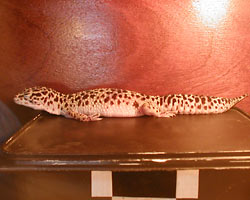
Recent
research has discovered that the skin of
house geckos (Hemidactylus turcicus) is extra-ordinarily
sensitive to UVB light; very low levels can enable large
quantities of vitamin D3 to be produced in their skin.9
In captivity, this would suggest that although their diet
can normally provide all the D3 they need, very brief daily
exposure to low levels of UVB might be beneficial, especially
if the diet was lacking in vitamin D3. If they were already
receiving maximum safe levels of vitamin D3 in dietary supplements,
however, there might be a risk of vitamin D overdosage from
the supplements.
Snakes
Few
snakes are thought to require ultraviolet lighting, at present,
since vitamin D3 from the diet is almost certainly adequate
for most species. However, some authors believe that
Diamond Pythons (Morelia spilota spilota) 37,
Indigo Snakes (Drymarchon corais)
39,
some aquatic species 11,
the insectivorous Rough and Smooth
Green Snakes (Opheodrys aestivus and O. vernalis)
and other arboreal, diurnal snakes
26,38
may benefit from low levels of UVB light in captivity. There
is also new research showing that even crepuscular corn
snakes can synthesise vitamin D3 if exposed to suitable
levels of UVB, so many species probably would benefit from
the ability to experience at least some gentle UVB during
daylight hours. Snakes are sensitive to excessively bright
artificial light, however, and this must be avoided.
|

















 UK
this may be 20-30 times the level they receive in the shade.
Many reptiles never choose to do so, however. Some species
live almost entirely in leafy shade or in burrows; nocturnal
reptiles and crepuscular (dawn and dusk) species actively
avoid bright daylight although some may bask in late evening
sun. Even sun-worshippers retreat from the sun at certain
times during the day, and many species are "shuttle heliotherms",
moving in and out of sunlight many times as they thermoregulate
during the course of the day.
UK
this may be 20-30 times the level they receive in the shade.
Many reptiles never choose to do so, however. Some species
live almost entirely in leafy shade or in burrows; nocturnal
reptiles and crepuscular (dawn and dusk) species actively
avoid bright daylight although some may bask in late evening
sun. Even sun-worshippers retreat from the sun at certain
times during the day, and many species are "shuttle heliotherms",
moving in and out of sunlight many times as they thermoregulate
during the course of the day.
 of years, our reptiles have lived in a world in which UVB,
UVA and visible light are all around them, and different
species have evolved in every ecological niche, with behaviours
(such as basking preferences) and body characteristics (such
as thick or thin skin, heavy or light pigmentation) to equip
them to use what UVB is available to them, in the most efficient
way possible.
of years, our reptiles have lived in a world in which UVB,
UVA and visible light are all around them, and different
species have evolved in every ecological niche, with behaviours
(such as basking preferences) and body characteristics (such
as thick or thin skin, heavy or light pigmentation) to equip
them to use what UVB is available to them, in the most efficient
way possible.  much closer to the UV source for several hours in the morning
and afternoon, moving away throughout the middle of the
day. This might be indicative of their behaviour in the
wild, where the natural heat, light and UVB levels reach
a high at midday. (Figure 3)
much closer to the UV source for several hours in the morning
and afternoon, moving away throughout the middle of the
day. This might be indicative of their behaviour in the
wild, where the natural heat, light and UVB levels reach
a high at midday. (Figure 3)  g from metabolic bone disorder (the result of a lack of UVB in
the past) basked directly underneath the UV source for most of the day, sitting as close as she could safely get (which with this particular lamp, was 12"). This dragon was never seen basking under the fluorescent tube that was provided for her before the mercury vapour lamp was installed. (Figure
4)
g from metabolic bone disorder (the result of a lack of UVB in
the past) basked directly underneath the UV source for most of the day, sitting as close as she could safely get (which with this particular lamp, was 12"). This dragon was never seen basking under the fluorescent tube that was provided for her before the mercury vapour lamp was installed. (Figure
4) such as the Mediterranean, Arizona and the Australian outback.
Peak readings of 350 - 450uW/cm² are commonplace for two
or three hours a day, around noon, in the summertime in
these areas; however, even "sun-worshippers" avoid
the midday sun. Observers usually report that most basking
is done in full sun before 10.30am, when readings are considerably
lower.
such as the Mediterranean, Arizona and the Australian outback.
Peak readings of 350 - 450uW/cm² are commonplace for two
or three hours a day, around noon, in the summertime in
these areas; however, even "sun-worshippers" avoid
the midday sun. Observers usually report that most basking
is done in full sun before 10.30am, when readings are considerably
lower.  un-necessarily.
un-necessarily.
 Their more sensitive skins manufacture all the vitamin D3
which they need from brief periods of basking early and
late in the day, and the diffused and reflected ultraviolet
light permeating the rainforest shade. All species of chameleon
have different requirements, but authors vary, too, in their
recommendations. The one scientific study we are aware of
addresses egg hatchability in Panther
Chameleons (Furcifer pardalis) and the authors
suggest that a low level of UVB (a gradient between 15-33uW/cm²
as measured with a Solarmeter 6.2) supplied for 12 hours
a day is optimal. High levels are seen to be harmful.
Their more sensitive skins manufacture all the vitamin D3
which they need from brief periods of basking early and
late in the day, and the diffused and reflected ultraviolet
light permeating the rainforest shade. All species of chameleon
have different requirements, but authors vary, too, in their
recommendations. The one scientific study we are aware of
addresses egg hatchability in Panther
Chameleons (Furcifer pardalis) and the authors
suggest that a low level of UVB (a gradient between 15-33uW/cm²
as measured with a Solarmeter 6.2) supplied for 12 hours
a day is optimal. High levels are seen to be harmful. somewhere between the two. Green
iguanas (Iguana iguana) have been observed
to bask for long periods in full sunlight early and late
in the day, when UVB levels are lower, then move to leafy
shade during the heat of the day. Here they avoid the high
UVB of the tropical noonday sun, which can be as high as
450 uW/cm², but they continue to be exposed to considerable
amounts of reflected and diffused UVB which may reach values
little different from those of the morning and evening sun
in which they bask freely; levels of 200uW/cm² have been
recorded.
somewhere between the two. Green
iguanas (Iguana iguana) have been observed
to bask for long periods in full sunlight early and late
in the day, when UVB levels are lower, then move to leafy
shade during the heat of the day. Here they avoid the high
UVB of the tropical noonday sun, which can be as high as
450 uW/cm², but they continue to be exposed to considerable
amounts of reflected and diffused UVB which may reach values
little different from those of the morning and evening sun
in which they bask freely; levels of 200uW/cm² have been
recorded.